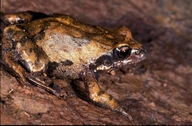|
Description
Philoria pughi is a relatively small frog (up to 30 mm in SVL), with a stout, pear-shaped body. The skin may be smooth, both dorsally and ventrally. Alternatively, there may be longitudinal dorsal ridges, or tubercles along the flanks and mid-dorsal line. This frog has a head that is shorter than wide, with a blunt snout and nostrils closer to the snout than the eye. Eyes are relatively large with horizontal pupils and blue sclera. Tympana are indistinct and small. The canthus rostralis is concave and well-defined. Vomerine teeth are arranged in two lateral plates separated at the midline, behind the level of the choanae. The tongue is rectangular. Fingers and toes are unwebbed, with digits being long and cylindrical. Finger lengths are, in decreasing order of length, 3>2>4>1. Toe lengths are 4>3>5>2>1. Both inner and outer palmar tubercles are small but distinct. There is a small, distinct inner metatarsal tubercle, but no outer metatarsal tubercle. Males have a very weakly developed nuptial pad on each thumb. Females have spatulae on the first and second fingers. The dorsal surface is generally plain orange or plain maroon, or orange with irregular dark patches; occasionally the color is bronze or tan. The upper surfaces of the limbs are maroon. A distinct crescent-shaped black patch is usually present on each flank. A black stripe runs posteriorly from snout through the eye, curving down to the base of the forearm. Ventrally the belly is yellow with red patches. A black patch is found over the cloacal area, which may sometimes extend onto the thighs. The lower surfaces of the hindlimbs are either mostly red, or yellow with numerous red splotches. Distribution and Habitat
Country distribution from AmphibiaWeb's database: Australia
Philoria pughi has been confirmed from seven localities in Australia: the Gibraltar Range; Billilimbra, Forestland, Girard, and Spirabo State Forests; Gibraltar Range NP, and Washpool NP, west of Grafton. It is found in the boggy headwaters of streams or temporary pools on the forest floor, in montane rainforests. This species has been reported from twelve additional localities, but the identity of the specimens as P. pughi has not been confirmed. Life History, Abundance, Activity, and Special Behaviors
This species is not abundant and populations have so far been reported to be quite small. At Spirabo State Forest, only six calling males were observed, and this was the largest number of calling males documented at any of the confirmed localities. Calling males and eggs were observed from October through December. Mating takes place in covered sites, such as burrows excavated in mud or under leaf litter or rocks; under creek banks; or in boggy areas, under sphagnum moss mats. Philoria pughi lays about 40 relatively large and fragile eggs in a ground nest, with a foamy mass surrounding the eggs. The female secretes jelly with the eggs, and beats the jelly into a foamy mass surrounding the eggs, with her large, spatulae-shaped fingers. The foam initially is frothy with many bubbles. Over time the foam loses its bubbles and settles into a still jelly. The larvae are apparently non-feeding; development through metamorphosis is supported entirely by yolk from the egg. Larvae complete development and metamorphose within the nest, emerging from the nest as juvenile frogs. Trends and Threats
This species seems to consist of relatively small populations in montane rainforests. Cattle have been reported to trample through creek headwaters and damage breeding areas, as well as potentially destroying eggs. Philoria pughi is currently protected in Gibraltar Range and Washpool National Park, but other populations of this species are not protected. Relation to Humans
None Possible reasons for amphibian decline General habitat alteration and loss
Habitat modification from deforestation, or logging related activities
Intensified agriculture or grazing
Habitat fragmentation
Comments
This species was named for Dailan Pugh of the North East Forest Alliance.
References
Knowles, R., Mahony, M., Armstrong, J., and Donnellan, S. (2004). ''Systematics of sphagnum frogs of the genus Philoria in eastern Australia, with the description of two new species.'' Records of the Australian Museum, 56(1), 57-74.
Originally submitted by: Gary Tsai (first posted 2005-10-24)
Edited by: Kellie Whittaker (2007-08-28)Species Account Citation: AmphibiaWeb 2007 Philoria pughi <https://amphibiaweb.org/species/6274> University of California, Berkeley, CA, USA. Accessed Nov 26, 2024.
Feedback or comments about this page.
Citation: AmphibiaWeb. 2024. <https://amphibiaweb.org> University of California, Berkeley, CA, USA. Accessed 26 Nov 2024.
AmphibiaWeb's policy on data use.
|



 Map of Life
Map of Life